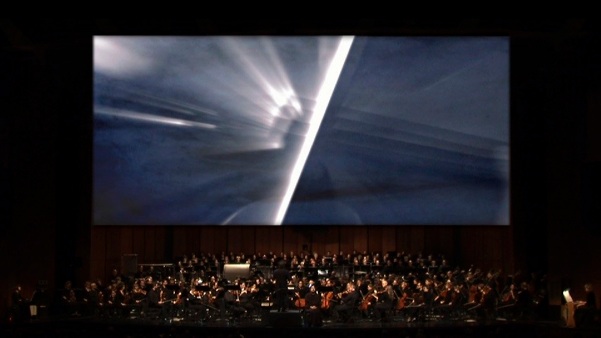Conceving a Visual Part
for Saint François d'Assise
by Olivier Messiaen

The conception of a visual part for a musical work, always starts for me with extending the musical composition into image. That means concretely to begin from the score and write image as if it was part of orchestration, extend instrumental gestures, illuminate the harmonic situations. The visual form and dramaturgy must then result from the musical form, help its perception, never contradict its unfolding.
In the particular case of an opera in concert situation, is added the necessity to clarify an action which is not theatrically represented, and which therefore risks to do not be understandable by the audience, who may not know the libretto by heart.
It is also, sometimes about helping the identification of the characters. For instance, in Ravel’s L'Enfant et les sortilèges the singers have several roles, and it is then very difficult in concert situation to know which character is singing at a given moment. I have for this reason conceive the principle of “virtual masks”: the face of the singer is doubled in video by a transparent mask which allows to clearly identify the character which is played, a process that also happen to be plastically interesting.
Similarly, the singers, captured live by cameras, are inserted in “virtual decors”, which unlike in the traditional situation at the theater or the opera, may vary continuously, transform to help the understanding of the action, but also in function of the musical composition. For instance, in the Wozzeck for Esa-Pekka Salonen and the Philharmonia of London in 2009 at the Royal Albert Hall, virtual decors were representing the reflections of the hallucinations than the character is undergoing, and for this, I used references to the pictorial universe of Franz Mac, contemporary of the writing of the opera.
In Saint François d’Assise, it is about restituting in the visual part all the richness of Messiaen’s music; to recreate in the image the living pictures that he has imagined and realized in the libretto and the music; to make correspond to the extraordinary palette of timbres, a palette of colors, inspired or the rich iconography which inspired himself, as well as of the theories of the composer about color.
The action of these “Franciscan scenes” is relatively simple and does not make major problem. Then, the visual part can principally be concerned by the understanding of the situations of the libretto, and especially on the musical development.
It is also about giving the possibility to see, thanks to cameras, the singers faces, which transport so much affects and expressions which are too often lost in a traditional opera presentation. This is including in this way that the visual part integrates completely in the concert, by creating a constant dialogue between the singers on the front of the stage, and their reflections on the screen above the orchestra, and does not constitute only a film which would run in parallel, indifferent to what is playing on the stage.
For these virtual decors, we are using as principal sources, on the one hand the real landscapes of Toscana and Umbria where the action happens, and on the other hand the pictures of Giotto, principally the ones which are in the Assise Basilique, and which have been a major source of inspiration for Messiaen.
These materials are never used directly, but are previously processed or serve as inspiration to compose the virtual decors in which the singers are transported live.
The virtual decors evolve by following the inside path traveled by François.
In the overall, the musical writing, rhythmic and timbral invention, offer fascinating visual parallels. Especially when we know how much Messiaen was passionate of colors, that he was seing them when composing and listening music. “Mes chords are colors. They generate intellectual colors, which evolve with them” (in Olivier Messiaen : Musique et couleur, entretiens avec Claude Samuel, Belfond 1986).
A direct application, transposing from the musical to the visual, of the colored universe of Messiaen, has never been attempted so far. It is not sure that it makes sense, as the descriptions that the composer has made of his colored visions seem really personal and difficult to reproduce and transmit.
However, the idea of a visual creation, respectful of the ideas of the composer, starting from the score to extend the composition into image, seem particularly timely.
The thousands of chords of Messiaen’s score, will be continued into image, in a attempt to restitute, the closest as possible, the “dazzlement” desired by the composer.
Jean-Baptiste Barrière
